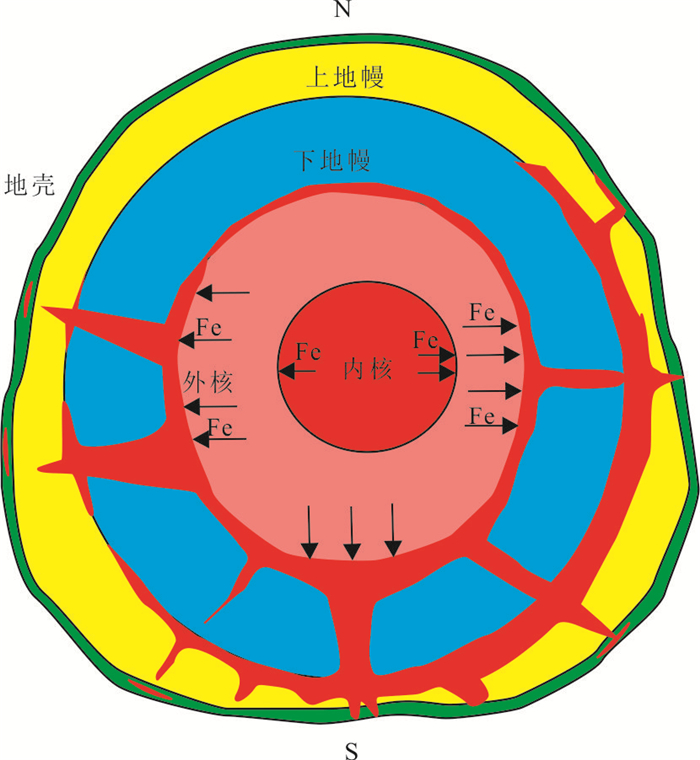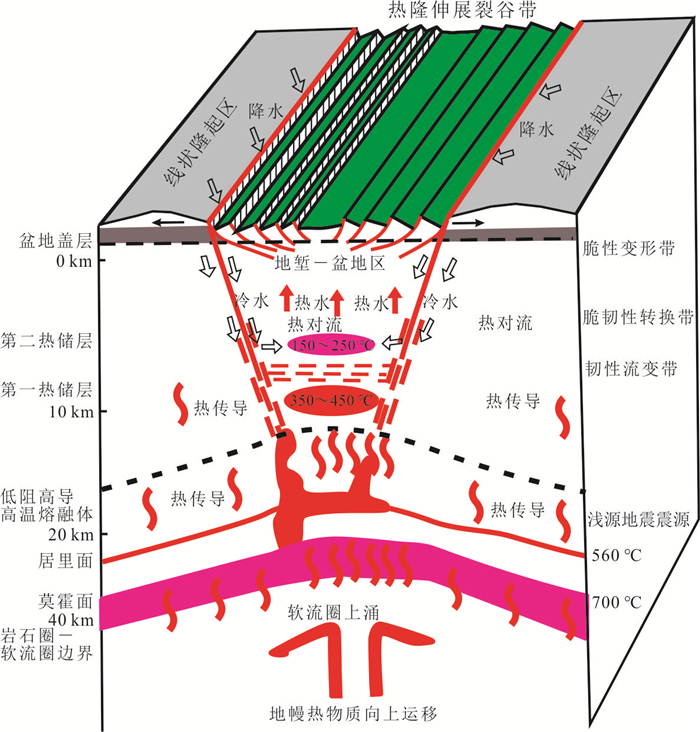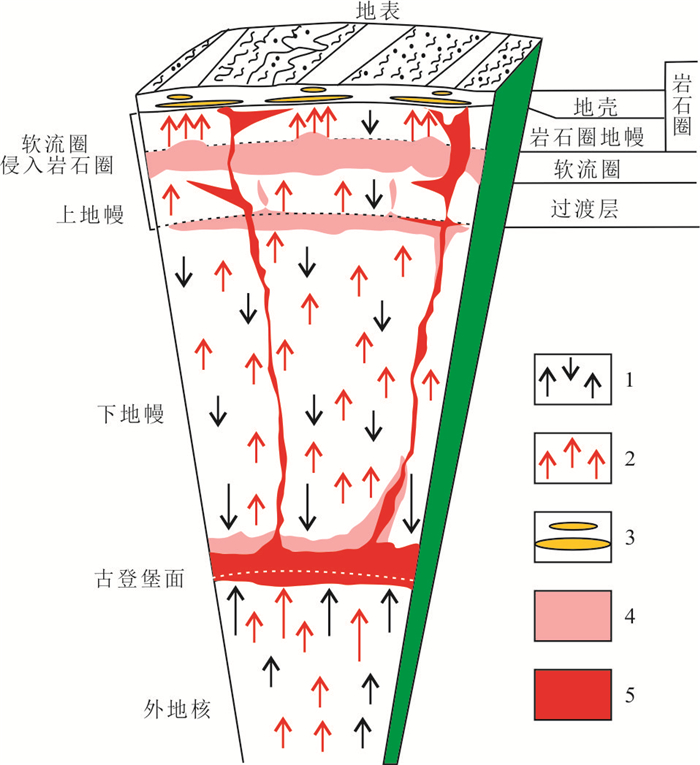Classification and Determination of Thermal Control Structural System of Hot Dry Rock
-
摘要: 为了研究干热岩成因机理,综合分析了干热岩形成背景、控热构造系统及尺度.地球中的干热岩具有特殊的形成构造背景,控热构造对干热岩热能的传输与聚敛具有很重要的作用,导致岩石圈不同热结构和热异常.控热构造可划分为生热、导热、储热和释热构造.生热构造包括地幔软流圈底辟,具有大量高放射性元素的岩浆房,活动性的深大断裂等;中、下地壳脆韧性转换带,活动的韧性剪切带是导热构造;中、下地壳的低阻高导体,韧性剪切流变层既是导热层,也是储热构造;火山、地震、浅表层次的活动断裂等为释热构造;控热构造的类型受到构造尺度和构造背景的限定.由于地壳中控热构造分布状态及发育特征差异较大,从而导致干热岩等地热能资源在地壳中的埋深、规模、热量以及分布状态等也有较大差异.Abstract: In order to study the genetic mechanism of hot dry rock (HDR), the formation background, thermal control structure system and scale of HDR are comprehensively analyzed in this paper.The distribution of HDR in the earth is not ubiquitous, but has its special tectonic background.The thermal controlling structure system plays a very important role in the transmission and accumulation of heat energy of HDR and causes different anomalies in the lithosphere.The thermal controlling structures can be further divided into four basic types: heat generating structure, heat conducting structure, heat storage structure and heat releasing structure.Heat generating structures include mantle asthenosphere diapir, magma chamber with large amount of high radioactive elements, active deep faults and so on.The brittle-ductile transitional zone in the middle and lower crust and the active ductile shear zone are thermal conductive structures.The ductile shear rheological layer is the heat conduction layer and the heat storage structure.Volcanoes, earthquakes, shallow active faults are heat releasing structures.The types of thermal control structure are limited by structural scale and tectonic setting.Due to the great differences in the distribution and development characteristics of heat controlling structures in the crust, the buried depth, scale, capacity and distribution state of geothermal energy such as hot dry rocks in the crust are also quite different.
-
图 2 热隆伸展区干热岩成因概念模型
据刘德民等(2020)修改
Fig. 2. Conceptual model of genesis of hot dry rocks in thermal uplift extension area
图 3 西宁地热田热储构造概念模型示意图(a)和关中盆地地热形成模式(b)
图a据张森琦等(2013)修改; 图b据穆根胥等(2015)修改
Fig. 3. Schematic diagram of conceptual model of heat reservoir structure in Xining geothermal field (a) and geothermal formation model of Guanzhong basin (b)
图 4 南海-内陆岩石圈流变分层结构图(a)和地震地壳测深HQ-13线横向速度结构(b)
图a据施小斌等(2000)修改; 图b据陈沪生(1988)修改. 实线为岩石圈结构分层界线, 虚线为流变层分界线; b.脆性层; d.韧性层;A.海底;B.新生界基底;C.上地壳底界;D.莫霍面;E.热岩圈底界
Fig. 4. Rheological stratification structure of South China Sea inland lithosphere (a) and lateral velocity structure of seismic crustal sounding HQ-13 line(b)
图 5 地球内部热物质运移示意图
据杨巍然等(2016)修改. 1. 重力运动潜势方向;2. 热能潜势方向;3. 地壳热流熔体(低速高导层);4. 地幔熔融热流体;5. 核幔边界形成的熔融热流体
Fig. 5. Schematic diagram of thermal material migration in the earth's interior
-
Artemievai, M., Thybo, H., Jakobsen, K., et al., 2017. Heat Production in Granitic Rocks: Global Analysis Based on a New Data Compilation Granite. Earth-Science Reviews, 172(2): 1-26. https://doi.org/10.1016/j.earscirev.2017.07.003. Chen, H.S., 1988. Comprehensive Geophysical Survey of HQ-13 Line in the Lower Yangzi Reaches and Its Geological Significance. Oil & Gas Geology, 9(3): 211-222, 327(in Chinese with English abstract). Ding, H.H., Ding, W.W., Zhang, F., et al., 2021. Asymmetric Deep Structure of the South China Sea Basin and Its Controlling Factors. Earth Science, 46(3): 929-941(in Chinese with English abstract). Freymark, J., Sippel, J., Scheck-Wenderoth, M., et al., 2017. The Deep Thermal Field of the Upper Rhine Graben. Tectonophysics, 694: 114-129. https://doi.org/10.1016/j.tecto.2016.11.013 Gan, H.N., Wang, G.L., Lin, W.J., et al., 2015. Research on the Occurrence Types and Genetic Models of Hot Dry Rock Resources in China. Science & Technology Review, 33(19): 22-27(in Chinese with English abstract). Hasterok, D., Chapman, D.S., 2011. Heat Production and Geotherms for the Continental Lithosphere. Earth and Planetary Science Letters, 307(1/2): 59-70. https://doi.org/10.1016/j.epsl.2011.04.034 Huang, Y., Li, Q.H., Sun, Y.J., et al., 2006. Review of Study on the Crust and Upper Mantle Structure in Jiangsu Province and Its Adjacent Areas. Northwestern Seismological Journal, 28(4): 369-376(in Chinese with English abstract). Jiang, G.Z., Li, W.W., Rao, S., et al., 2016. Heat Flow, Depth-Temperature, and Assessment of the Enhanced Geothermal System (EGS) Resource Base of Continental China. Environmental Earth Sciences, 75(22): 1432. https://doi.org/10.1007/s12665-016-6238-5 Lay, T., Hernlund, J., Buffett, B.A., 2008. Core-Mantle Boundary Heat Flow. Nature Geoscience, 1(1): 25-32. https://doi.org/10.1038/ngeo.2007.44 Li, D.W., Wang, Y.X., 2015. Major Issues of Research and Development of Hot Dry Rock Geothermal Energy. Earth Science, 40(11): 1858-1869(in Chinese with English abstract). Li, X.L., Wu, G.L., Lei, Y.D., et al., 2016. Suggestions for Geothermal Genetic Mechanism and Exploiation of Zhangcang Temple Geothermal Energy in Guide County, Qinghai Province. Journal of Jilin University (Earth Scienc Edition), 46(1): 220-229 (in Chinese with English abstract). Lin, W.J., Wang, G.L., Shao, J.L., et al., 2021. Distribution and Exploration of Hot Dry Rock Resources in China: Progress and Inspiration. Acta Geologica Sinica, 95(5): 1366-1381(in Chinese with English abstract). Liu, D.M., Zhang, C.S., Sun, M.H., et al., 2021. Evaluation Indexes and Formation Conditions of Hot Dry Rock Exploration. Bulletin of Geological Science and Technology, 40(3): 1-11(in Chinese with English abstract). Liu, D.M., Zhang, G.Y., Guan, J.P., et al., 2020. Analysis of Geothermal Resources Potential for Hot Dry Rock in the Subei Basin. Earth Science Frontiers, 27(1): 48-54(in Chinese with English abstract). Ma, Z.Y., Li, X.C., Zheng, H.J., et al., 2017. Origin and Classification of Geothermal Water from Guanzhong Basin, NW China: Geochemical and Isotopic Approach. Journal of Earth Science, 28(4): 719-728. https://doi.org/10.1007/s12583-016-0637-0 Mu, G.X., Li, F., Yan, W.Z., et al., 2015. Occurrence Law of Geothermal Resources and Key Technologies for Development and Utilization in Guanzhong Basin. Geology Press, Beijing(in Chinese). Naif, S., Key, K., Constable, S., et al., 2013. Melt-Rich Channel Observed at the Lithosphere—Asthenosphere Boundary. Nature, 495(7441): 356-359. https://doi.org/10.1038/nature11939 National Energy Administration, 2019. The Energy Industry Standard of the People's Republic of China-Terminology of Geothermal Energy(NB-T 10097-2018). Sinopec Press, Beijing (in Chinese). Nelson, K.D., Zhao, W.J., Brown, L.D., et al., 1996. Partially Molten Middle Crust beneath Southern Tibet: Synthesis of Project INDEPTH Results. Science, 274(5293): 1684-1688. https://doi.org/10.1126/science.274.5293.1684 Pollack, H.N., Hurter, S.J., Johnson, J.R., 1993. Heat Flow from the Earth's Interior: Analysis of the Global Data Set. Reviews of Geophysics, 31(3): 267-280. https://doi.org/10.1029/93rg01249 doi: 10.1029/93RG01249 Qi, J.F., Yang, Q., 2010. Cenozoic Structural Deformation and Dynamic Processes of the Bohai Bay Basin Province, China. Marine and Petroleum Geology, 27(4): 757-771. https://doi.org/10.1016/j.marpetgeo.2009.08.012 Sclater, J.G., Jaupart, C., Galson, D., 1980. The Heat Flow through Oceanic and Continental Crust and the Heat Loss of the Earth. Reviews of Geophysics, 18(1): 269-311. https://doi.org/10.1029/rg018i001p00269 doi: 10.1029/RG018i001p00269 Shi, X.B., Zhou, D., Zhang, Y.X., 2000. Thermal Rheological Structure of Continental Margin Lithosphere in the Northern South China Sea. Chinese Science Bulletin, 45(15): 1660-1665 (in Chinese with English abstract). doi: 10.1360/csb2000-45-15-1660 Tanaka, A., Yamano, M., Yano, Y., et al., 2004. Geothermal Gradient and Heat Flow Data in and around Japan (Ⅰ): Appraisal of Heat Flow from Geothermal Gradient Data. Earth, Planets and Space, 56(12): 1191-1194. https://doi.org/10.1186/bf03353339 doi: 10.1186/BF03353339 Tanaka, H., Chen, W.M., Kawabata, K., et al., 2007. Thermal Properties across the Chelungpu Fault Zone and Evaluations of Positive Thermal Anomaly on the Slip Zones: Are these Residuals of Heat from Faulting? Geophysical Research Letters, 34: L01309. https://doi.org/10.1029/2006gl028153 Teng, J.W., Si, X., Zhuang, Q.X., et al., 2019. Fine Structures of Crust and Mantle and Potential Hot Dry Rock beneath the Zhangzhou Basin. Chinese Journal of Geophysics, 62(5): 1613-1632(in Chinese with English abstract). Wang, C.Y., Li, Y.H., Lou, H., 2016. Issues on Crustal and Upper-Mantle Structures Associated with Geodynamics in the Northeastern Tibetan Plateau. Chinese Science Bulletin, 61(20): 2239-2263(in Chinese with English abstract). doi: 10.1360/N972016-00160 Wang, G.L., Lin, W.J., Zhang, W., et al., 2016. Research on Formation Mechanisms of Hot Dry Rock Resources in China. Acta Geologica Sinica-English Edition, 90(4): 1418-1433. https://doi.org/10.1111/1755-6724.12776 Wang, G.L., Zhang, W., Liang, J.Y., et al., 2017. Evaluation of Geothermal Resources Potential in China. Acta Geoscientia Sinica, 38(4): 448-459(in Chinese with English abstract). Wang, J.Y., 2015. Geothermics and Its Applications. Science Press, Beijing (in Chinese). Wang, J.Y., Hu, S.B., Pang, Z.H., et al., 2012. Estimate of Geothermal Resources Potential for Hot Dry Rock in the Continental Area of China. Science & Technology Review, 30(32): 25-31(in Chinese with English abstract). Wang, M.L., Chen, B.Y., Liang, X.F., et al., 2015. Surface Wave Tomography for South China and the Northern South China Sea Area. Chinese Journal of Geophysics, 58(6): 1963-1975(in Chinese with English abstract). Wang, S.F., Pang, Z.H., Liu, J.R., et al., 2013. Origin and Evolution Characteristics of Geothermal Water in the Niutuozhen Geothermal Field, North China Plain. Journal of Earth Science, 24(6): 891-902. https://doi.org/10.1007/s12583-013-0390-6 Wang, Y., Wang, J., Xiong, L.P., et al., 2001. Lithospheric Geothermics of Major Geotectonic Units in China Mainland. Acta Geosicientia Sinica, 22(1): 17-22(in Chinese with English abstract). Weinstein, S.A., 1993. Catastrophic Overturn of the Earth's Mantle Driven by Multiple Phase Changes and Internal Heat Generation. Geophysical Research Letters, 20(2): 101-104. https://doi.org/10.1029/93gl00044 doi: 10.1029/93GL00044 Witter, J.B., Trainor-Guitton, W.J., Siler, D.L., 2019. Uncertainty and Risk Evaluation during the Exploration Stage of Geothermal Development: A Review. Geothermics, 78(1): 233-242. https://doi.org/10.1016/j.geothermics.2018.12.011 Wu, X.Y., Mou, R., Shi, S.Q., et al., 1999. Relationship between Volcanic Rocks and Structural Evolution in Subei Basin. Petroleum Explorationist, 4(1): 44-47, 7(in Chinese with English abstract). Xiao, Z. C., Wang, S., Qi, S. H., et al., 2020. Petrogenesis, Tectonic Evolution and Geothermal Implications of Mesozoic Granites in the Huangshadong Geothermal Field, South China. Journal of Earth Science, 31(1): 141-158. https://doi.org/10.1007/s12583-019-1242-9 Xiong, S.Q., Yang, H., Ding, Y.Y., et al., 2016. Characteristics of Chinese Continent Curie Point Isotherm. Chinese Journal of Geophysics, 59(10): 3604-3617(in Chinese with English abstract). Xu, L., Wang, L.S., Yang, Q., 2014. An Estimation of Hot-Dry-Rock(HDR) Resources in Jiangsu Province. Geological Journal of China Universities, 20(3): 464-469(in Chinese with English abstract). Yang, W.R., Jiang, C.F., Zhang, K., et al., 2016. Opening-Closing Tectonics: Exploration of a New Idea on Global Tectonics. Earth Science Frontiers, 23(6): 42-60(in Chinese with English abstract). Yuan, Y.S., Ma, Y.S., Hu, S.B., et al., 2006. Present-Day Geothermal Characteristics in South China. Chinese Journal of Geophysics, 49(4): 1118-1126(in Chinese with English abstract). Zhang, B.J., Li, Y.Y., Gao, J., et al., 2020. Genesis and Indicative Significance of Hot Dry Rock in Matouying, Hebei Province. Acta Geologica Sinica, 94(7): 2036-2051(in Chinese with English abstract). Zhang, C., Hu, S.B., Song, R.C., et al., 2020. Genesis of the Hot Dry Rock Geothermal Resources in the Gonghe Basin: Constraints from the Radiogenic Heat Production Rate of Rocks. Chinese Journal of Geophysics, 63(7): 2697-2709(in Chinese with English abstract). Zhang, C., Hu, S.B., Zhang, S.S., et al., 2020. Radiogenic Heat Production Variations in the Gonghe Basin, Northeastern Tibetan Plateau: Implications for the Origin of High-Temperature Geothermal Resources. Renewable Energy, 148: 284-297. https://doi.org/10.1016/j.renene.2019.11.156 Zhang, S.Q., Li, X.F., Song, J., et al., 2021. Analysis on Geophysical Evidence for Existence of Partial Melting Layer in Crust and Regional Heat Source Mechanism for Hot Dry Rock Resources of Gonghe Basin. Earth Science, 46(4): 1416-1436(in Chinese with English abstract). Zhang, S.Q., Xu, W.L., Yan, W.D., et al., 2013. Geothermal Geology of Xining Basin. Geology Press, Beijing (in Chinese). Zhang, Z.J., Liu, Y.F., Zhang, S.F., et al., 2010. The Depth-Dependence of Crustal Extension beneath Qiongdongnan Basin Area and Its Tectonic Implications. Chinese Journal of Geophysics, 53(1): 57-66(in Chinese with English abstract). Zuo, Y.H., Qiu, N.S., Pang, X.Q., et al., 2013. Geothermal Evidence of the Mesozoic and Cenozoic Lithospheric Thinning in the Liaohe Depression. Journal of Earth Science, 24(4): 529-540. https://doi.org/10.1007/s12583-013-0347-9 陈沪生, 1988. 下扬子地区HQ-13线的综合地球物理调查及其地质意义. 石油与天然气地质, 9(3): 211-222, 327. https://www.cnki.com.cn/Article/CJFDTOTAL-SYYT198803000.htm 丁航航, 丁巍伟, 张帆, 等, 2021. 南海海盆区深部结构的不对称性及控制因素. 地球科学, 46(3): 929-941. doi: 10.3799/dqkx.2020.338 甘浩男, 王贵玲, 蔺文静, 等, 2015. 中国干热岩资源主要赋存类型与成因模式. 科技导报, 33(19): 22-27. https://www.cnki.com.cn/Article/CJFDTOTAL-KJDB201519012.htm 黄耘, 李清河, 孙业君, 等, 2006. 江苏及邻区地壳上地幔结构研究. 西北地震学报, 28(4): 369-376. https://www.cnki.com.cn/Article/CJFDTOTAL-ZBDZ200604016.htm 李德威, 王焰新, 2015. 干热岩地热能研究与开发的若干重大问题. 地球科学, 40(11): 1858-1869. doi: 10.3799/dqkx.2015.166 李小林, 吴国禄, 雷玉德, 等, 2016. 青海省贵德扎仓寺地热成因机理及开发利用建议. 吉林大学学报(地球科学版), 46(1): 220-229. https://www.cnki.com.cn/Article/CJFDTOTAL-CCDZ201601021.htm 蔺文静, 王贵玲, 邵景力, 等, 2021. 我国干热岩资源分布及勘探: 进展与启示. 地质学报, 95(5): 1366-1381. https://www.cnki.com.cn/Article/CJFDTOTAL-DZXE202105004.htm 刘德民, 张昌生, 孙明行, 等, 2021. 干热岩勘查评价指标与形成条件. 地质科技通报, 40(3): 1-11. https://www.cnki.com.cn/Article/CJFDTOTAL-DZKQ202103001.htm 刘德民, 张根袁, 关俊朋, 等, 2020. 苏北盆地干热岩地热资源前景分析. 地学前缘, 27(1): 48-54. https://www.cnki.com.cn/Article/CJFDTOTAL-DXQY202001007.htm 穆根胥, 李锋, 闫文中, 等, 2015. 关中盆地地热资源赋存规律及开发利用关键技术. 北京: 地质出版社. 国家能源局, 2019. 中华人民共和国能源行业标准地热能术语(NB-T 10097-2018). 北京: 中国石化出版社. 施小斌, 周蒂, 张毅祥, 2000. 南海北部陆缘岩石圈热-流变结构. 科学通报, 45(15): 1660-1665. https://www.cnki.com.cn/Article/CJFDTOTAL-KXTB200015016.htm 滕吉文, 司芗, 庄庆祥, 等, 2019. 漳州盆地精细壳、幔异常结构与潜在干热岩探讨. 地球物理学报, 62(5): 1613-1632. https://www.cnki.com.cn/Article/CJFDTOTAL-DQWX201905005.htm 王椿镛, 李永华, 楼海, 2016. 与青藏高原东北部地球动力学相关的深部构造问题. 科学通报, 61(20): 2239-2263. https://www.cnki.com.cn/Article/CJFDTOTAL-KXTB201620005.htm 王贵玲, 张薇, 梁继运, 等, 2017. 中国地热资源潜力评价. 地球学报, 38(4): 448-459. https://www.cnki.com.cn/Article/CJFDTOTAL-DQXB201704002.htm 汪集暘, 2015. 地热学及其应用. 北京: 科学出版社. 汪集暘, 胡圣标, 庞忠和, 等, 2012. 中国大陆干热岩地热资源潜力评估. 科技导报, 30(32): 25-31. https://www.cnki.com.cn/Article/CJFDTOTAL-KJDB201232017.htm 王敏玲, 陈赟, 梁晓峰, 等, 2015. 华南及南海北部地区瑞利面波层析成像. 地球物理学报, 58(6): 1963-1975. https://www.cnki.com.cn/Article/CJFDTOTAL-DQWX201506012.htm 汪洋, 汪集暘, 熊亮萍, 等, 2001. 中国大陆主要地质构造单元岩石圈地热特征. 地球学报, 22(1): 17-22. https://www.cnki.com.cn/Article/CJFDTOTAL-DQXB200101003.htm 吴向阳, 牟荣, 石胜群, 等, 1999. 苏北盆地火成岩发育与构造演化的关系. 勘探家, 4(1): 44-47, 7. https://www.cnki.com.cn/Article/CJFDTOTAL-KTSY199901010.htm 熊盛青, 杨海, 丁燕云, 等, 2016. 中国陆域居里等温面深度特征. 地球物理学报, 59(10): 3604-3617. https://www.cnki.com.cn/Article/CJFDTOTAL-DQWX201610008.htm 徐立, 王良书, 杨谦, 2014. 江苏干热岩地热资源潜力估算. 高校地质学报, 20(3): 464-469. https://www.cnki.com.cn/Article/CJFDTOTAL-GXDX201403012.htm 杨巍然, 姜春发, 张抗, 等, 2016. 开合构造: 新全球构造观探索. 地学前缘, 23(6): 42-60. https://www.cnki.com.cn/Article/CJFDTOTAL-DXQY201606011.htm 袁玉松, 马永生, 胡圣标, 等, 2006. 中国南方现今地热特征. 地球物理学报, 49(4): 1118-1126. https://www.cnki.com.cn/Article/CJFDTOTAL-DQWX200604024.htm 张保建, 李燕燕, 高俊, 等, 2020. 河北省马头营干热岩的成因机制及其示范意义. 地质学报, 94(7): 2036-2051. https://www.cnki.com.cn/Article/CJFDTOTAL-DZXE202007012.htm 张超, 胡圣标, 宋荣彩, 等, 2020. 共和盆地干热岩地热资源的成因机制: 来自岩石放射性生热率的约束. 地球物理学报, 63(7): 2697-2709. https://www.cnki.com.cn/Article/CJFDTOTAL-DQWX202007019.htm 张森琦, 李旭峰, 宋健, 等, 2021. 共和盆地壳内部分熔融层存在的地球物理证据与干热岩资源区域性热源分析. 地球科学, 46(4): 1416-1436. doi: 10.3799/dqkx.2020.094 张森琦, 许伟林, 严维德, 等, 2013. 西宁盆地地热地质. 北京: 地质出版社. 张中杰, 刘一峰, 张素芳, 等, 2010. 琼东南盆地地壳伸展深度依赖性及其动力学意义. 地球物理学报, 53(1): 57-66. https://www.cnki.com.cn/Article/CJFDTOTAL-DQWX201001008.htm -










 下载:
下载:





